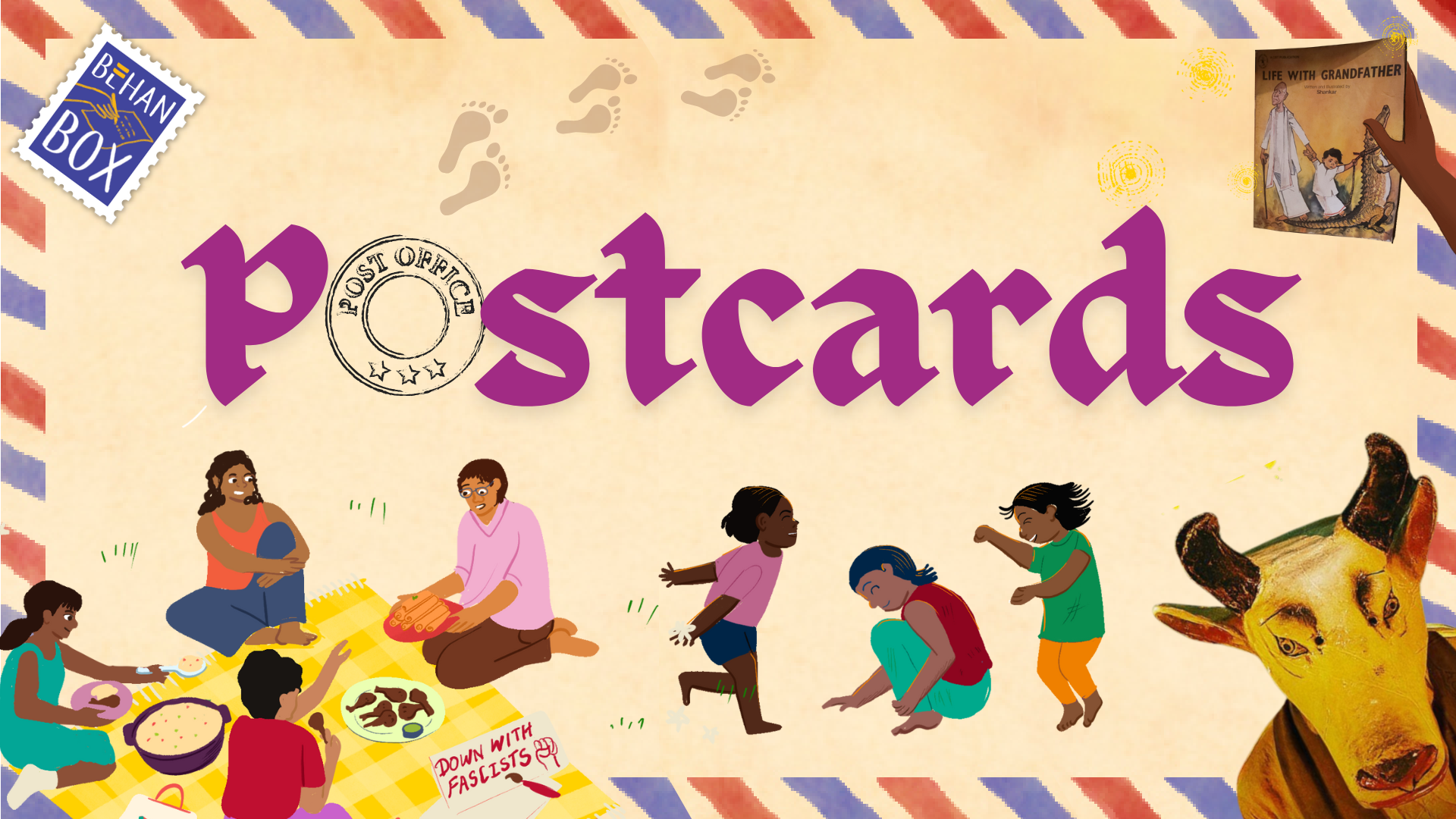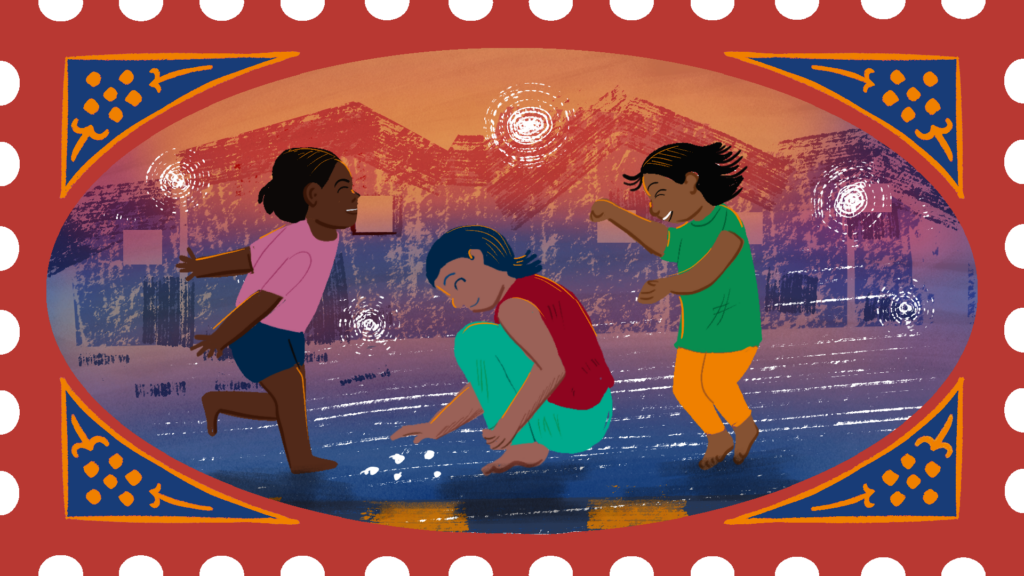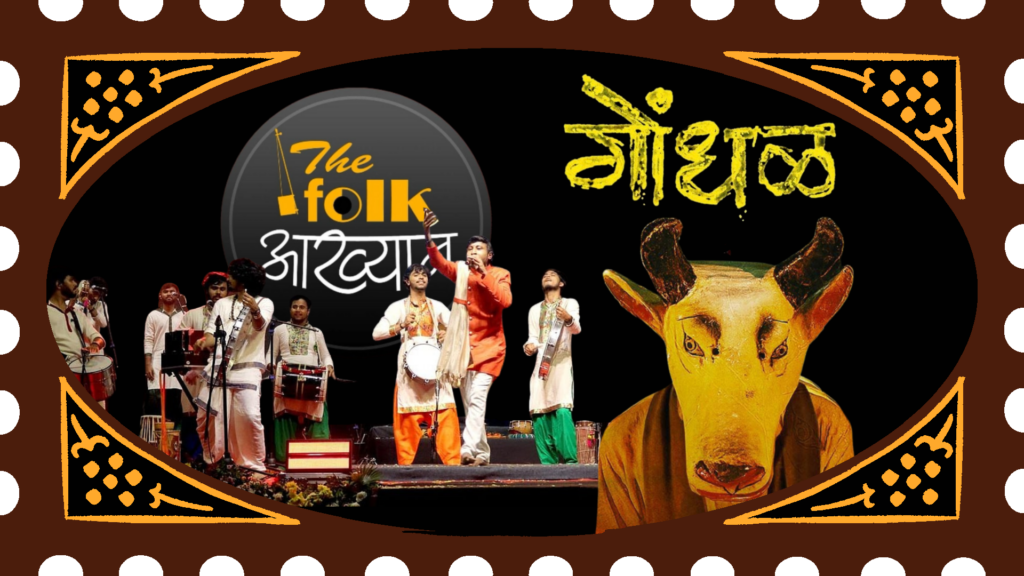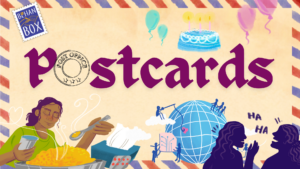Postcards: From Protest Parties To Riotous Angry Women
This month in Postcards: notes on Maharashtra’s Lok Kala, Shankar’s priceless children’s books, and more

Dear reader, we write to you about the people, places, and ideas that brought team BehanBox joy this month. One postcard, every month.
Behans, as the year comes to a close, we’re sending handwritten postcards as a small note of our gratitude for the time and care you’ve shown to your stories. If you’d like one in your mailbox, share your postal address with us at contact@behanbox.com or DM us on Instagram. We’d love to write to you.
Learning To Laugh With Children

“She’s full of confidence and has so much self-love,” my friend said, while we watched her four-year-old niece running from one end of the room to the other, entertaining herself and filling the entire house with her contagious laughter. She walked over to us in her colourful jutis and demanded, “didi, race with me!” pulling me by my arm to the start line.
As I played with her, hiding behind walls and catching her, laughter bubbled-up loudly from inside me and I felt my bitterness melt away. We shrieked and tickled each other, and I suddenly realised I had been holding my breath all day as I dealt with violence wrapped up in adult politeness and fake laughter. I was reminded of a conversation I had with children from Mumbai’s Siddharth Nagar whose houses were recently demolished.
“When they broke our house, we cried. We thought all of us [friends] would be separated. We played so many games in our galli. Sometimes we hid on top of the bathroom. Other times we jumped into the naali. We used to catch fish also… We are not scared of anyone. When the bulldozer came back after fixing its tyre that we punctured, we broke its windshield instead!” they said laughing. It made me think – what role and importance should ‘play’ have in our collective movements and everyday struggles?
I have felt rage intensely in every corner and moment of this month. But throughout, it has been these small, simple moments of play with children that have brought out hope and joy in me, balancing and guiding my rage towards holding people and systems accountable. From children, I am learning what it truly means to “speak truth to power”, never hesitating to say things as they are while loving, playing and caring deeply.
Anjali
Hot Flashes, Punk Anthems, And The Audacity To Be Seen

“Am I invisible to you?” Beth asks her supervisor at her school. A reasonable question, considering the night before she had made all the arrangements to hang herself when her phone rang. Twice.
Call one: her brother, demanding to know why she’d put their mum who had dementia in a fancy care home paid for by her life savings, which could have been their inheritance.
Call two: “Do you want to join a rock band?” asked her friend Jess.
Honestly, if the universe sends you an invitation to punk-rock your way out of a breakdown, you say yes.
Thus five women, ages 45 to 60, formed a punk rock band: The Riot Women. BBC’s new series Riot Women, penned by the formidable Sally Wainwright, was exactly the televised therapy I didn’t know I was waiting for. Here were women wrestling menopause, eldercare, singledom, and, most of all, that uniquely female superpower: being completely invisible while standing in the middle of the room. Invisible at work, at home, to the healthcare system — pick a structure, any structure, and these women had been ghosted by it.
So naturally, they wrote a song: “Seeing Red.”
They bellow:
“Am I invisible?
Am I untouchable?
Am I unlovable?
Are you uncomfortable?
And I’m seeing red, red, red, red, red, red…”
And suddenly I’m up off the couch, and like a woman possessed, bang the side table as if summoning the Holy Spirit of Rage. Then comes the greatest chorus line ever in television: “Give me HRT!”
Tears of actual joy roll down. The kind that not even perimenopause can evaporate.
We live in a society that dismisses middle-aged women’s anger as “hormonal”. My friend, who turned 50 recently, calls this phase “my age to give precisely zero flying fucks” — a phrase I intend to tattoo on my forehead.
Next year I enter the fabulous side of 50 myself, and I can already feel the Riot Woman in me stretching, cracking her knuckles, and adjusting her mic stand.
And yes: GIVE ME HRT.
Bhanupriya Rao

Finding My Way Back To a Beloved Children’s Book

One of the few pleasures of the pre-Diwali clean-up marathon this year was my admirable (even if I say so myself) effort to catalogue our books. The most fun part of the mission lay in sorting the children’s books that go back way back — to my childhood, my husband’s and our son’s.
There are books from over 50 years ago, tattered and dogeared, names written in pencil with proprietorial pride on the front page, a hark back to the time when books were precious, unaffordable, hard to get and certainly not available at the press of a button. Every Thursday, a mobile Delhi Public Library came to the colony, delivering a treasure trove of books, all bound for some reason in faded blue. There was of course the school library and those delightfully cheap children’s books from the erstwhile Soviet Russia.
But it was the wonderful Children’s Book Trust founded by the great political cartoonist Shankar that brought us some priceless books — gorgeously illustrated, affordable and totally relatable. My favourite was Life With Grandfather, written and illustrated by Shankar. Published in 1965 and reprinted several times over in many languages, it was a movingly evocative book about little Raja, a boy being raised by his grandparents in a Kerala village (note coconut trees, men in mundu, women in mundu and rouka, elephants). It was a sun-dappled world, full of love and mischief, and yes, some dark moments too.
The grandfather looked a lot like mine, tall, ramrod straight, bare chested and very strict. Raja is much-loved but also a handful, tangling with a truant crocodile, making friends with an elephant and more keen to draw than study. He also cannot see why he cannot be hugged by Chirutha, the untouchable domestic worker.
I lost my copy but the book and its sunshine cover remained imprinted in my memory. So imagine the delight when I saw it in a corner of a bookshop ready for my son aged 5. He grew up and lost interest in it. It now sits among my books.
Malini Nair
Tag Along For This Protest Party?

A mildly sunny afternoon, the air still damp from the night’s rain, but skies had cleared up. I made my way into a session with a dozen people and a dozen snacks laid out on the table. Garlic peanuts, dried jackfruit, prawn crackers, more packaged delicacies laid out in colourful bowls with names I couldn’t read. At the centre was the question: If your protest could be a potluck party, what would you bring, who is invited?
This was the final day of a conference held in what felt like Bangkok’s version of Jawaharlal Nehru University. From Peru to the Philippines, Mexico to India, I found the story was the same: civic freedoms are under assault, global institutions have failed, a handful of people command wealth, real estate, and attention, online and offline. In other words: things aren’t great, they haven’t been great for a while, something needs to change. Over conversations and in action, I saw glimpses of what this change looked like. It was as if everyone had agreed to work on this collective canvas, brushing with stories and colour and art, these insistent strokes of resistance that could be understood beyond borders.
At the potluck party, we naturally spoke in stories and in metaphors too. Protests as masquerade balls, underground raves, arts and culture festivals. Resistance came decked in flamboyance and frivolity, it dripped off politics and scented courage. It was cool and kitschy. Of course, not everyone appreciated this style. A human rights lawyer from Cambodia said the “government was the biggest party pooper”. In Indonesia, there were no places to hold these parties. Indians related and how, I said while scooping a handful of peanuts. Plus, it took time and resources and privilege to show up at a party, and when you did, it was either too noisy or clique-y or you lived in the fear of being eternally grounded.
We commiserated with each other, and like old friends discussing love and loss, offered counsel while passing on some banana chips. Reels help with reach, yes, and what about colours as symbols, like Gen Z in Indonesia did? Someone read a poem they wrote and we took a picture to remember this moment when hearts felt at ease and hope felt within reach.
Do you remember Andor, how the Rebel Alliance in the show has a secret code “I have friends everywhere” to prove their allegiance and trustworthiness to others? But don’t we mean this literally too, I thought, that to build movements and brew revolutions one needs friends everywhere?
Saumya Kalia
An Ode to Maharashtra’s Lok Kala

Maharashtra is said to be a land of lok kala (folk art). We have Dashavtar, Lavani, Povada, Gondhal… each coming from its own rooted history, shaped by the people who perform it. And yet these art forms are slowly being forgotten.
Last week, I took myself to a performance by Folk Akhyaan, a group of young singers from villages across Maharashtra who’ve come together to sing the journey of lok kala itself. Their voices walked us through history. From one song to another, we moved from Shivaji to the saints, from Sant Tukaram to the Samyukta Maharashtra movement, pausing to remember the contributions of Shahir Annabhau Sathe and Babasaheb Ambedkar to Marathi, to the state and the people. “Marathi belongs to the people, not to the politicians who use it to divide and discriminate,” said the narrator. I walked away thinking how lok kala has survived not because of institutions but because of the people who hold these arts.
Maybe that’s why the film I watched recently, Gondhal, touched me so deeply. Gondhal is a ritualistic performance, traditionally held during festivals, weddings, or other sacred occasions, and its style varies from village to village. It is performed by the Gondhali community, many of whom belong to Dalit communities. For them, Gondhal is not just art, it’s a form of livelihood deeply tied to their caste identity and ancestral traditions.
The movie begins with a child asking a simple question: “Why do people perform Gondhal?”
The story unfolds over a single night of Gondhal, following a wedding. Villagers gather to pray for the couple’s wellbeing and the Gondhalis perform through the night until dawn. Within that performance, the film tells the story of a young bride forced into a marriage, her naive husband, and the son of the powerful Patil, the richest landowner of the village, who is smitten by her. You see the bride’s ambition and fearlessness, while also witnessing the violence and entitlement of the Patils. And yet, the Gondhal continues. I was surprised to learn that the song Chandana in the film was produced by Ilaiyaraaja.
And my luck was unreal – the actors walked into the theatre once the movie ended. Kishore Kadam, one of the protagonists and whom you might know from Fandry, spoke about wanting to spread awareness about the art form.
Lok kala is slipping away. With no support from the government or the public, artists struggle to sustain themselves. People are forgetting the stories, the history, the songs. I keep returning to the narrator’s words at the end of the Folk Akhyaan performance. The colorful parade was coming to an end, he bemoaned, we had arrived at a grave – the grave of lok kala. And I fear we are all simply watching its burial as if it were someone else’s loss.
Urvi Sawant
Want to explore more newsletters? Our weekly digest Behanvox and monthly Postscript invite you, the reader, into our newsroom to understand how the stories you read came to be – from ideation to execution. Subscribe here or visit our Substack channel for more.
Did you hear about The ASHA Story, the feminist archive we are building that documents the story of ASHA workers? You can contribute to it too. Write to us contact@behanbox.com.
We believe everyone deserves equal access to accurate news. Support from our readers enables us to keep our journalism open and free for everyone, all over the world.




